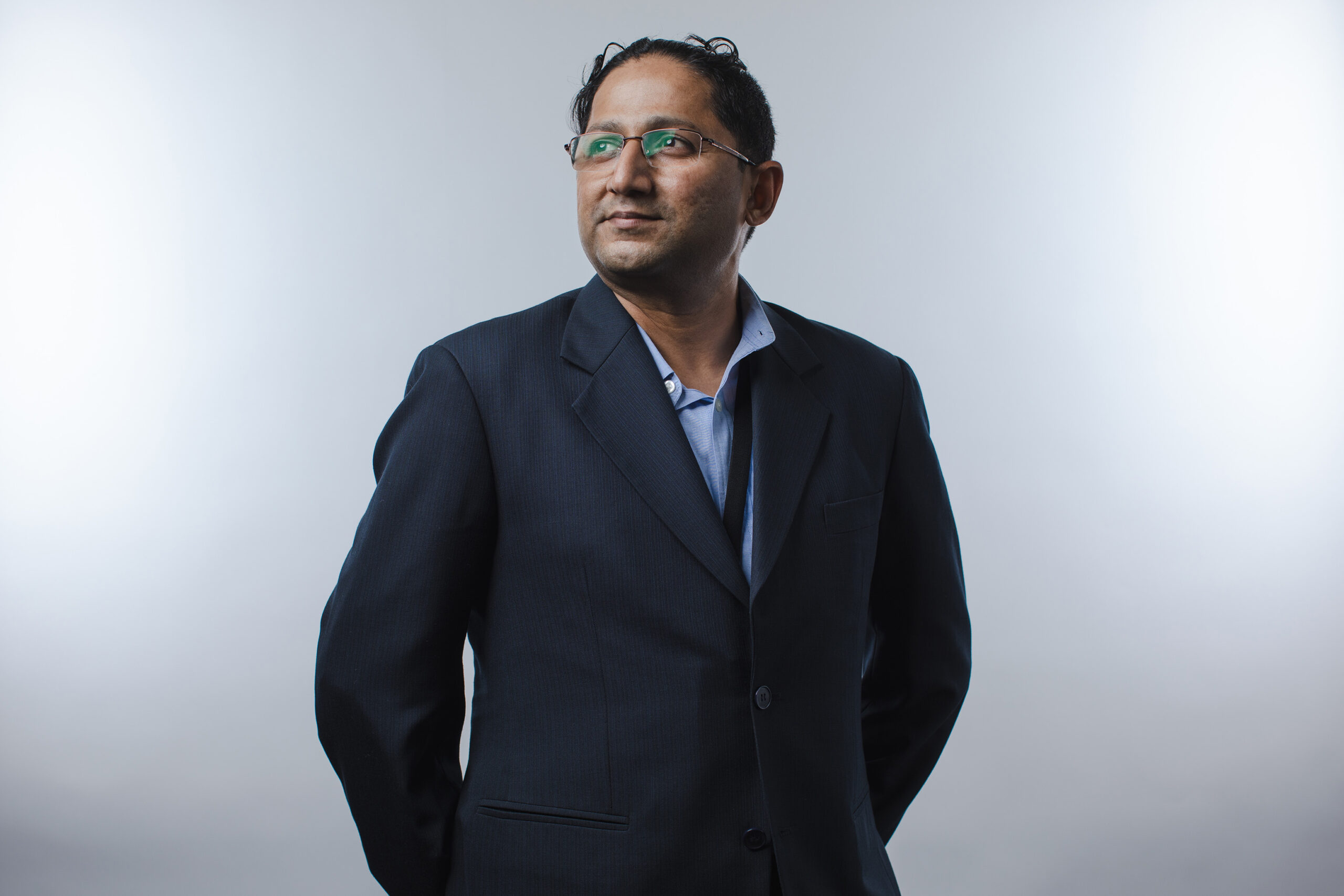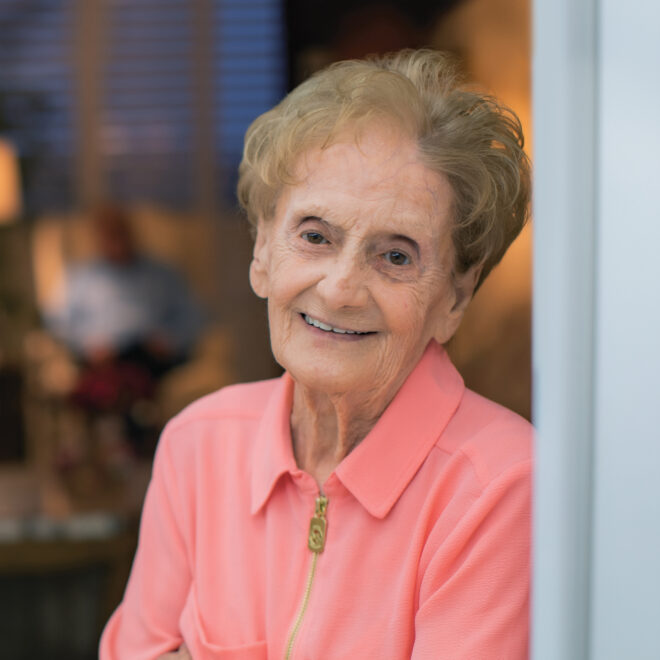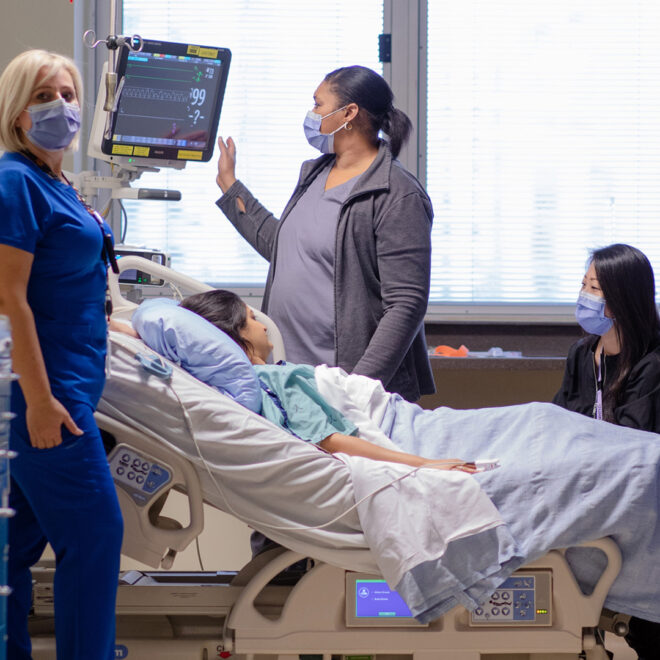
Rebecca Collier-Doyle is proud of the team's collective drive to bring innovation to patients with heart disease at the Peter Munk Cardiac Centre.
Tim Fraser
Advancing efficiency, enhancing care
The Peter Munk Cardiac Centre’s non-invasive aortic valve replacement surgery means more patients are discharged the same day as their procedure.
Steven Bush was no stranger to heart surgery when he arrived for a consult at the Structural Heart Valve Clinic at University Health Network’s Peter Munk Cardiac Centre in January 2022. In the years leading up to this visit, Bush had undergone a stenting procedure to clear a blocked artery, a pacemaker implant to regulate heart rhythm and a pacemaker replacement, but he was still plagued by fatigue and an alarmingly slow heart rate.
Bush met with Dr. RJ Cusimano, a cardiovascular surgeon at the Peter Munk Cardiac Centre and holder of the David & Stacey Cynamon Professorship in Cardiovascular Surgery Innovation and Education, who spent over an hour with him reviewing his records. Both encouraged and surprised by the thorough attention he received during this consultation, Bush learned his problems with heart rate and energy level could likely be solved with an aortic valve replacement through a transcatheter aortic valve implantation, also known as a TAVI.
A TAVI is a cutting-edge, minimally invasive procedure performed on select patients suffering from severe to critical aortic stenosis – a heart valve disease involving the narrowing of the aortic valve.

TAVI procedures replace diseased aortic valves with new, healthy valves. Via a catheter inserted in the leg, the new valve is guided directly inside the one being replaced. Once positioned, the new valve is inflated – pushing the old valve tissue up against the sidewall of the aorta and out of its way – and begins working immediately.
140%
140 per cent increase in the number of TAVIs performed at the Peter Munk Cardiac Centre in 2020, with 240 performed, compared to 2015.
Originally developed as an alternative for patients, often 80 or older, who are too sick or high-risk to survive open-heart surgery, TAVIs are now being conducted on younger, less complex patients as well.
“With outcomes continuing to be as good as they are, patients with low and medium risk are also being assessed for TAVI eligibility,” says Rebecca Collier-Doyle, a Clinical Nurse Coordinator at the Peter Munk Cardiac Centre.
Bush, at age 77, turned out to be one of those younger, less-complex patients. After undergoing a series of assessments to ensure his condition would best be treated by a TAVI, he was scheduled to undergo an “awake TAVI” – meaning he would not be put under general anesthetic – in August 2022.
Awake TAVIs lead to shorter hospital stays
When the Peter Munk Cardiac Centre team first began performing TAVI procedures in 2007, patients were put under general anesthetic. As techniques were honed and technology evolved, the team realized they could eliminate the use of general anesthetic while still ensuring patient safety.
The first awake TAVI in Ontario was performed at the Peter Munk Cardiac Centre in January 2015. Now, 95 per cent of patients at the Peter Munk Cardiac Centre undergo TAVIs while in a conscious sedation state. Local anesthesia is used at the entry site of the catheter insertion and an anesthesiologist supervises the patient’s vital signs, ensuring they are stable and comfortable.
The use of local anesthetic allows for faster recovery and a shorter length of stay in the hospital. In many cases, patients at the Peter Munk Cardiac Centre who undergo an awake TAVI are discharged – following a thorough assessment – the same day of their procedure, as opposed to the standard two to three day hospital stay.

“We are constantly looking at how to be more efficient for both the hospital and the patient,” says Collier-Doyle, whose role involves educating patients about TAVI, preparing them in advance of their surgery, and helping coordinate the multidisciplinary team collaborating on each TAVI procedure.
95%
95 per cent of patients at the Peter Munk Cardiac Centre undergo TAVIs while in a conscious sedation state, referred to as ‘awake TAVIs’.
Collaboration leads to positive outcomes
Despite a TAVI’s seeming simplicity – the procedure itself takes about 30 to 45 minutes – a great deal of planning, collaboration and creative thinking occurs across disciplines to make each one happen.
Every week, a team of structural heart disease interventional cardiologists, cardiac surgeons, anesthesiologists and nursing care coordinators meets to discuss TAVI candidate cases. Each candidate undergoes a series of imaging tests prior to the procedure. Among the most crucial is the gated cardiac CT, or a TAVI CT, which takes exact measurements of the patient’s heart, valves and vessels to and from the heart to determine their eligibility and the size of the replacement valve required.
“We are constantly looking at how to be more efficient for both the hospital and the patient.”
Rebecca Collier-Doyle
30-45 minutes
Although TAVI procedures only take about 30 to 45 minutes, each one requires a great deal of multidisciplinary planning, collaboration and creative thinking.
Since interpreting a TAVI CT requires special training and insight, the team works closely with radiologists such as Dr. Jaydeep Halankar, whose focus is structural heart disease. Since his arrival at the Peter Munk Cardiac Centre in 2019, Dr. Halankar has helped facilitate more complex TAVI procedures, including valve-in-valve replacements, which use TAVIs to replace old artificial valves.
In collaboration with the interdisciplinary team, Dr. Halankar reviews each patient’s TAVI CTs and discusses his findings at their weekly meeting. “This opens the lines of communication and forms an effective collaboration,” he says. “We look at the valve together as we discuss and decide on the right procedure for the valve replacement required.”
Exploration leads to advancements
Thanks to the Peter Munk Cardiac Centre’s multidisciplinary, highly collaborative approach, when Bush arrived for his TAVI procedure early one morning in August 2022, he felt prepared, informed and confident he was in good hands.
Like many TAVI patients at the Peter Munk Cardiac Centre, Bush was in and out of the hospital in under 24 hours. “There was a big team there that day,” he says, adding that while under conscious sedation he dozed in and out but could engage with the team whenever he wanted to ask questions. Only a few hours later, Bush was able to sit up and walk, and by early evening, he was discharged.
“Many of the things we’re able to do at the Peter Munk Cardiac Centre aren’t being done elsewhere in Canada.”
Dr. Jaydeep Halankar
“I heard that some people in TAVI recovery get up from the operating table and want to dance,” Bush says. “It wasn’t quite like that for me, but I feel in better health now than I was before the procedure and follow-up tests show I’m in good shape.”
Results like Bush’s help propel innovations in TAVIs forward so patients can continue to receive better, more efficient care. “This clinical research is near and dear to me because it’s constantly evolving,” says Dr. Halankar. “We’re learning so many new things on an exponential level, and many of the things we’re able to do at the Peter Munk Cardiac Centre aren’t being done elsewhere in Canada.”
For Collier-Doyle, this collective drive to bring innovation to TAVI patients is a big part of what makes her job so rewarding. “I’m very proud of our advancements, and that we are constantly working to improve our program,” says Collier-Doyle. “I feel a strong level of responsibility to our patients. I want to see each of them get the best procedure and outcomes.

